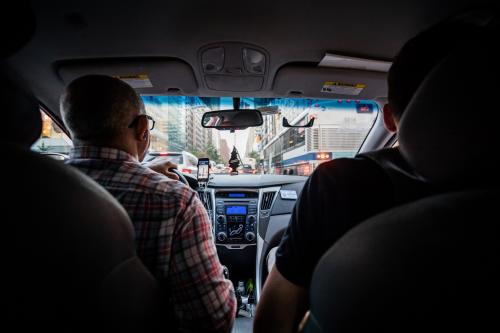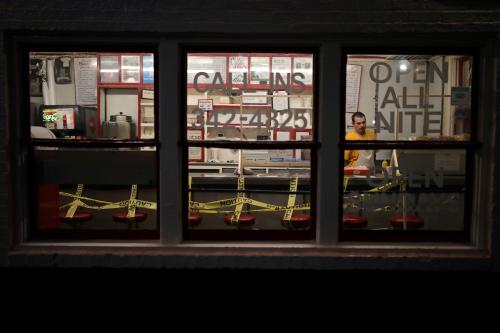“Visualizing Vulnerable Jobs Across America” is a new interactive tool from the Workforce of the Future initiative to help local policymakers better understand job vulnerability by sector and subsector for 380 metropolitan areas and 50 states plus Washington, D.C. Incorporating detailed data on the scale and dispersion of vulnerable jobs, the tool also allows for comparison between different areas. Armed with this information, local leaders can identify where job vulnerability exists in their economies and devise ways to enhance workers’ resilience to economic shocks as localities recover and grow.
The economic impacts of COVID-19 have been felt locally—in cities and towns across the United States, already shuttering more than 100,000 businesses and putting nearly 15 million workers out of a job. The crisis has exposed a deep insecurity pervading America’s labor markets, particularly low-wage markets, driving some states’ unemployment rates to record levels. While reopening efforts in June brought back some jobs, July’s widespread increases in COVID-19 cases threaten to reverse these gains, further destabilizing labor markets and compounding the uncertainty felt by millions of American workers struggling to get back on their feet.
But challenges of insecure employment are not new. Even before the pandemic, low-wage work in the United States was far from stable. Our research has shown how low-wage workers more often churn through low-wage jobs, struggling to move up in the economy with uneven access to the tools that support mobility: education, skilling pathways, and employer-provided career development opportunities. Many of these workers were prime picks for layoffs when COVID-19 hit their communities, exposing vulnerabilities masked during years of employment growth.
As state and local leaders focus on economic relief and recovery, greater attention to job vulnerability can guide their efforts to build back better.
Defining vulnerability
We define a “vulnerable” job as one that (1) pays low wages (less than the median wage, adjusted for location), and (2) is not covered by employer-sponsored health care benefits. Under this metric, 19 percent of U.S. jobs were vulnerable in 2018.
Workers in vulnerable jobs face the dual challenge of scraping by on low pay and managing their own health care—an issue thrown into sharp relief by COVID-19. As of March 2019, only 40 percent of workers in the lowest wage quartile had jobs that offered employer-provided health care benefits, compared to 93 percent in the highest wage quartile. Employers who offer health insurance are also more likely to invest in other measures of job quality such as retirement benefits, paid time off, maternity leave, or sick leave.
The insights offered by this tool and the vulnerability metric should be considered in the context of America’s persistent racial disparities. Black and Hispanic workers disproportionately face the consequences of job vulnerability. These groups are overrepresented within the low-wage workforce and among essential workers, millions of whom have been forced to choose between their finances and their physical well-being at low-paying, high-exposure jobs. In May, Black unemployment continued to rise even as the rate improved for white workers. Regional policymakers must rebuild inclusive economies—a process that will require a better understanding of who has been left behind in our labor market and workforce arrangements.
Using the interactive to understand the drivers of vulnerability
The country’s largest sectors also have the most vulnerable jobs: At the national level, hospitality and retail have the highest proportions of vulnerable jobs—47 percent and 32 percent, respectively (Figure 1). Health care, which employs more Americans than any other sector, is the third largest source of vulnerable jobs. The share of vulnerable workers in each sector can vary greatly from region to region, however. For example, the share of vulnerable workers in health care ranges from 8 percent in Maui, Hawaii to 49 percent in McAllen, Texas.
The Myrtle Beach metropolitan area on the South Carolina-North Carolina border, meanwhile, provides an example of how industry mix can drive vulnerability in a local economy. The region’s workforce is concentrated in the hospitality and retail sectors, which together employ nearly 40 percent of workers (compared to 20 percent of workers nationally). The concentration gives Myrtle Beach the country’s 15th highest proportion of vulnerable jobs.
Notably, economies driven by sectors that are characterized by high levels of job vulnerability do not always result in high shares of vulnerable workers. Consider Las Vegas, whose hospitality-driven economy relies on casinos, hotels, restaurants, and entertainment—industries that have high shares of vulnerable jobs nationally. But Las Vegas hospitality and culinary workers have negotiated less precarious employment, reflected in the city’s low sector vulnerability (see Figure 2).
This helped workers in the sector to confront the pandemic: While Nevada’s unemployment reached nearly 30 percent in April, hospitality workers in Las Vegas have been able to preserve health care benefits, secure recall rights to bring laid-off workers back once the industry recovers, and advocate for safe and equitable reopening procedures. While the sector’s reopening will still be turbulent, these arrangements may help provide a safety net to support workers’ long-term health and employment prospects while also preserving employer-employee relations.
Figure 2. Strong worker protections drive down vulnerability in Las Vegas compared to peers
Public policy has a role to play, too
In states like Hawaii, low levels of job vulnerability across sectors have been supported by economy-wide legislation (Figure 3). The state’s expansive Prepaid Healthcare Act (PPHA) requires employers of all sizes to provide health insurance to employees who work at least 20 hours per week. Unfortunately, COVID-19 exposed how fragile even bold public policies like PPHA can be: Hawaii’s job losses between February and May led to an estimated 72 percent increase in uninsured adults from 2018 levels, compared to a 21 percent increase nationwide. Still, the increase left 10 percent of the adults in Hawaii without health insurance, compared to 16 percent nationwide. The outcome illustrates a reality across the United States: Given our patchwork system of labor protections, with 55 percent of Americans relying on private employer-provided insurance, improving job quality is only one component of enhancing workers’ resilience.
Public policy has a role to play, too
In states like Hawaii, low levels of job vulnerability across sectors have been supported by economy-wide legislation (Figure 3). The state’s expansive Prepaid Healthcare Act (PPHA) requires employers of all sizes to provide health insurance to employees who work at least 20 hours per week. Unfortunately, COVID-19 exposed how fragile even bold public policies like PPHA can be: Hawaii’s job losses between February and May led to an estimated 72 percent increase in uninsured adults from 2018 levels, compared to a 21 percent increase nationwide. Still, the increase left 10 percent of the adults in Hawaii without health insurance, compared to 16 percent nationwide. The outcome illustrates a reality across the United States: Given our patchwork system of labor protections, with 55 percent of Americans relying on private employer-provided insurance, improving job quality is only one component of enhancing workers’ resilience.
Vulnerability, economic complexity, and recovery strategies
For the country’s workforce to thrive, regional economies need to grow and attract industries that offer low-vulnerability, high-quality jobs. Our research on regional economic complexity shows that if cities develop the capabilities to attract and host complex industries, they can drive growth. Complex industries (such as professional services or information technology) tend to have fewer vulnerable jobs, and as cities build complexity, they tend to bring more people into the labor market by accelerating growth and increasing opportunities for work. Notably, however, cities that host complex industries also tend to have higher shares of low-wage and vulnerable jobs—for every high-paying tech job, one or more lower-paid jobs may be generated (e.g., food servers at the restaurant where tech workers eat lunch, or the cleaning staff in the hotels where their families stay on visits.)
As cities recover and focus on supporting complex industries, vulnerability metrics can provide a window into the quality of jobs generated across sectors. Since economic growth can result in the creation of new vulnerable jobs, local leaders must understand and confront the unique drivers of vulnerability to prioritize decent work and strong employer-employee bonds.
The cases of Las Vegas and Hawaii show that some regions were successful in reducing vulnerability before the pandemic through their industry mix, local labor market arrangements, and the scope of available worker benefits. In recovery, evolving business models and shifting consumer preferences will require public and private leaders to consider how their region’s unique mix of industries will be affected—to help workers rapidly adapt and provide the unemployed with better pathways for reentry, during and beyond the pandemic.
Modernize worker benefits
As we have argued, modernized and expanded benefits can offer critical support to low-wage workers, especially as they look towards a post-COVID economy. A system of portable and expansive benefits—including health, retirement, job placement, training, and other areas—would allow workers to keep their benefits when they transition between employers or through periods of unemployment. Proposals put forward by several states would allow employers to contribute to a single statewide fund that would, in turn, provide health insurance, retirement, skills training, and other benefits to employees through individual accounts. This model could be uniquely beneficial for workers at small businesses, who are less likely to have access to health care benefits, even in good times.
Support firms to improve job quality
Firms, immersed in local markets and communities, will play a key role in shaping the new future of work. As COVID-19 fundamentally alters the economy, companies can help their workers adapt to new business models and consumer demands if buoyed by targeted public support.
Driving down vulnerability can be a boon for business. For example, Zeynep Ton’s research on the retail industry—a sector where a third of the jobs are vulnerable—shows that investing in employees does not come at the cost of profitability. This is borne out anecdotally as businesses like QuikTrip, Trader Joe’s, and Costco have shown that profitability is compatible with investment in workers.
Of course, the state of the economy today is radically different than it was mere months ago. With high rates of bankruptcy at both small and large firms, many are just focused on survival. Given these realities, public sector support can encourage firm-level investments in keeping and retraining workers. Without public sector support that provides firms with a longer runway to adapt, more workers will fall behind, and the post-COVID recovery will be prolonged.
Conclusion
Job vulnerability metrics are no panacea for the complex and highly localized forces that stand in the way of economic recovery and equity. But they can help answer critical questions facing the policymakers seeking to design an inclusive recovery: Where are the weak spots in my economy? How do I stack up against my peers? Where can I do better? Finally, they can highlight the places where public and private sector leaders act boldly to reduce job vulnerability, foster trust between workers and employers, and provide workers with a base of economic and physical protections to better withstand the next economic shock.








Commentary
Visualizing vulnerable jobs across America: A tool to understand your local economy and inform its recovery
July 28, 2020